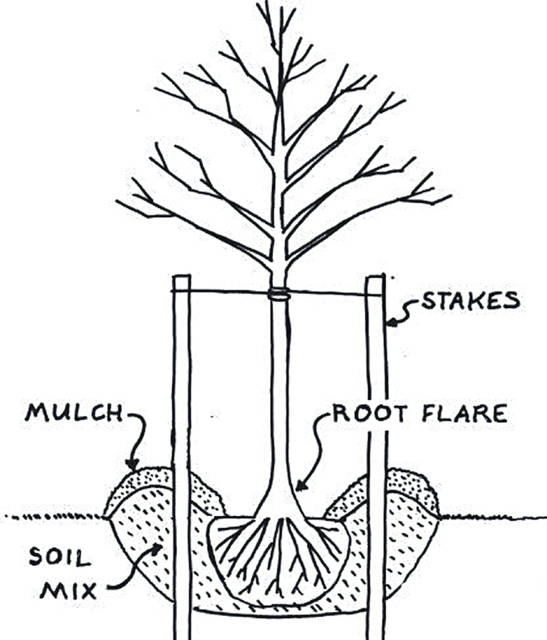

Perhaps it’s our German heritage, but we’re compulsive about training young trees to grow straight and true; in a word: “plumb”. Merriam-Webster defines plumb as “(adverb) straight down or up: vertically” and “(noun) a lead weight attached to a line and used to indicate a vertical direction”. Of course we’re not talking about multi-trunk or “clump-form” trees, but about single-trunk trees. There are always exceptions, but most single-trunk trees naturally grow pointing straight up.
When planting single-trunk trees, staking them straight is an important step. Whether grown in a container or dug “balled and burlapped”, chances are a young tree’s root system isn’t heavy or wide enough to prevent wind from pushing it crooked or even knocking it down. Constant wind pressure from one direction (generally from the southwest) will cause un-staked trees to lean crooked over time. Once they grow roots and get established, this is a very hard problem to fix.
Wind gusts can damage the tree by uprooting it and breaking the tender new roots it needs to get established. Think of a newly planted tree as a ball and socket; its wind resistance and top-heaviness exert leverage, causing the root ball to rotate in the ground, tearing fragile roots. Trying to stop this rotation by planting the tree deeper will suffocate the tree; you should never cover the top of the root system with soil. Planting too deep is a major cause of death for newly planted trees.
To stake a tree properly you’ll need sturdy stakes at least six feet long, so that you can drive them deep in the ground and still have three or four feet of stake showing. We like to use six foot pencil-point oak stakes for most trees, but for really big trees we prefer seven-foot steel “T-posts” (fence posts) because they’re stronger, longer and easier to drive into hard ground.
Starting on the southwest side of the tree, using a stake driver, drive a stake at least two feet into the undisturbed soil far enough from the tree that it’s well outside the planting hole. For leverage, lean the stakes slightly away from the tree. The second and third stakes should be evenly spaced around the tree, the same height and distance from the trunk.
Using stout rope, strapping or wire, loop a piece around the trunk and back to each stake. NEVER wrap anything around the trunk; just one loop around the tree and back to the stake, then attach your loop securely to the stake. Straps won’t damage the tree bark, but if you use wire or rope you must pass it through a piece of garden hose to prevent trunk damage. We like to use “poly chain lock”, a special strapping made just for tree staking, because it’s gentle on the trunk and easy to adjust. Where it passes around the stake we run a screw through it to prevent it from slipping down.
We believe that tree stakes should remain in place for two years, three at most. After that, it’s good for the wind to rock the tree because it encourages strong buttress roots and a nicely tapered, strong trunk structure. Oak stakes will rot over time and can be easily broken off at the ground once they’re not needed. Metal T-posts need to be pulled out. In the meantime we like to check and adjust the tightness of the straps; tight enough to keep the tree from leaning but not so tight that the tree can’t rock a bit from side to side.
Does all this sound complicated? Remember that our three-stake method is ideal. Two stakes opposite each other are enough in most cases. A single stake, on the side of the tree that most wind pressure comes from, is far better than nothing at all. A key to success is using stakes
long enough so that the rope or wire goes horizontally (level) across from the stake to the tree, as high on the tree as possible. Years from now, you’ll take pleasure in watching your tree stand straight like a soldier at attention. Particularly if you’re German…



